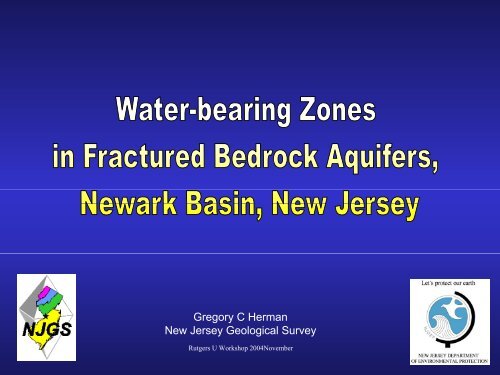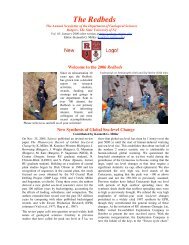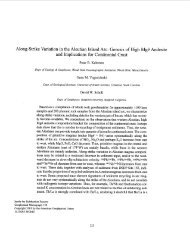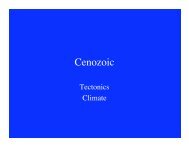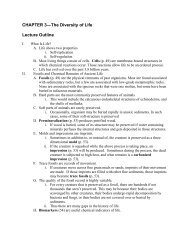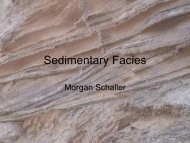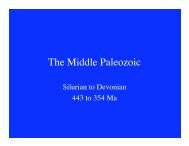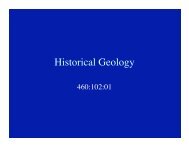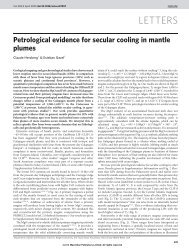Water-bearing Zones in Fractured Bedrock Aquifers, Newark Basin ...
Water-bearing Zones in Fractured Bedrock Aquifers, Newark Basin ...
Water-bearing Zones in Fractured Bedrock Aquifers, Newark Basin ...
You also want an ePaper? Increase the reach of your titles
YUMPU automatically turns print PDFs into web optimized ePapers that Google loves.
See examples of how water-<strong>bear<strong>in</strong>g</strong> zones arecomposed of either s<strong>in</strong>gle or multiple water<strong>bear<strong>in</strong>g</strong>featuresDemonstrate how the NJGS <strong>in</strong>terprets, classifies,and catalogues <strong>in</strong>formation on water-<strong>bear<strong>in</strong>g</strong>featuresHow we use this <strong>in</strong>formation to develop profilehydrogeological frameworks that reflectstratigraphic and structural controls on groundwaterflow, <strong>in</strong>clud<strong>in</strong>g measurable borehole crossflows
The identification and classification of water-<strong>bear<strong>in</strong>g</strong>features primarily relies upon the use of slim-l<strong>in</strong>egeophysical tools to log the physical properties ofthe formation and the borehole fluids for the tapped<strong>in</strong>terval of the aquifer.<strong>Bedrock</strong> cores provide direct geological evidenceStraddle-packer tests provide measurements of thevolume yield of water from specific <strong>in</strong>tervals (usually20’ sections)
<strong>Water</strong>-<strong>bear<strong>in</strong>g</strong> features are identified and characterized primarily us<strong>in</strong>gfour geophysical <strong>in</strong>struments:Fluid temperature and electrical conductivity (or resistivity) probe thatlogs changes <strong>in</strong> the fluid chemistry, usually associated with water-entryor exit po<strong>in</strong>ts <strong>in</strong> the boreholeCaliper tool – measures the diameter of the borehole and <strong>in</strong>dicates<strong>in</strong>tervals where the borehole is enlargedDigital Optical Televiewer (DOPTV)– provides direct visual <strong>in</strong>spection ofthe water-<strong>bear<strong>in</strong>g</strong> feature and it’s 3D orientationHeat-pulse flow meter (HPFM) – measures the speed and direction offluids <strong>in</strong> a borehole
DOPTV also provides a record of the borehole geometry and is used tomeasured and categorize the various bedrock structures
The heat-pulse flow meter is one type of flow meter that provides a directmeasure of the fluid speed and direction of flow <strong>in</strong> the borehole
The HPFM is lowered <strong>in</strong>to the borehole <strong>in</strong>to a stationary position at specified depthswhere it is allowed to stabilize with respect to the fluid mov<strong>in</strong>g around and through it.A heat-pulse is fired to create a warmed fluid front that is carried to either the upper orlower thermistor by fluids mov<strong>in</strong>g <strong>in</strong> the borehole.Fluid speed is calculated from the arrivaltime of a heat pulse us<strong>in</strong>g a simplelogarithmic formulae programmed <strong>in</strong>to thedata acquisition software.Fluid speed is multiplied by a boreholeconstant to obta<strong>in</strong> the volume flow atvarious depths <strong>in</strong> the borehole.
The volume and direction of water flow is measured and recorded at multipledepths and comb<strong>in</strong>ed with other geophysical logs to create a profile<strong>in</strong>terpretation of the aquifer framework.
<strong>Bedrock</strong> aquifer studies where water-<strong>bear<strong>in</strong>g</strong> features have been analyzed arecatalogued by the NJGS us<strong>in</strong>g a HTML based <strong>in</strong>terface
Catalogued data are also compiled by aquifer, County and Municipality
Catalog entries <strong>in</strong>clude an <strong>in</strong>dex map show<strong>in</strong>g the well locations on a base map,and an <strong>in</strong>teractive list of catalog entries <strong>in</strong>clud<strong>in</strong>g geophysical log summaries,histogram and stereonet structural analyses summariz<strong>in</strong>g feature orientations,and sometimes a profile <strong>in</strong>terpretation of the hydrogeolgoical framework
Brunswick aquiferWatchungzoneupperredzonemiddlegrayzonelowerredzonePrimary aquifers <strong>in</strong> thedatabase <strong>in</strong>clude theStockton, Lockatong, andBrunswickThe Brunswick aquifer issubdivided <strong>in</strong>to five zonesbased on the distributionof red gray, and blacklithologic colorslowergrayzoneLockatongaquiferStocktonaquiferThese zones are used forexam<strong>in</strong><strong>in</strong>g the ability ofdifferent bedrock units tostore and transmit waterand to evaluate waterquality as a function ofstratigraphic controlPaul Olsen and Others, Lamont-Doherty Geological Observatory and Roy Schlische, Rutgers University
<strong>Water</strong>-<strong>bear<strong>in</strong>g</strong> zones (WBZs) consist of a s<strong>in</strong>gle or multiple water <strong>bear<strong>in</strong>g</strong>features (WBFs) that are effectively porous and hydraulically conductiveWBFs are either related to stratigraphic layer<strong>in</strong>g or fractures other thanlayer<strong>in</strong>gWBFs related to stratigraphic layer<strong>in</strong>g are categorized as mechanical(fracture) part<strong>in</strong>gs between beds or compositional layers or layers hav<strong>in</strong>geffective matrix porosityWBFs related to fractur<strong>in</strong>g are categorized as either tectonic fractures or otherfractures stemm<strong>in</strong>g from all other processes <strong>in</strong>clud<strong>in</strong>g weather<strong>in</strong>g,exhumation, erosion, unload<strong>in</strong>g, etc.A third category of WBFs consists of <strong>in</strong>tersections of layer<strong>in</strong>g and fractures
Layered WBFs related to mechanical (fracture) layer<strong>in</strong>g often occur at thecontacts between beds of vary<strong>in</strong>g gra<strong>in</strong> sizePassaic conglomeratic sandstoneRidgewood Boro, Bergen CountyPassaic conglomerate and sandstoneBedm<strong>in</strong>ster Twp., Somerset CountyPassaic Fm. mudstone and shale,Hopewell Twp., Mercer County
Fracture part<strong>in</strong>gs along mechanical layers provide pathways for aquifer recharge
Layered WBFs also occur where networks of conductivepores occur <strong>in</strong> specific sedimentary bedsSta<strong>in</strong>ed pores <strong>in</strong> Stockton sandstoneEw<strong>in</strong>gville Twp., Mercer CountyPores <strong>in</strong> desiccated Passaic Fm. mudstoneand siltstone, Penn<strong>in</strong>gton Boro, Mercer CountyPores <strong>in</strong> Passaic Fm. sandstoneRidgewood Boro, Bergen County
This class of layered WBF <strong>in</strong>cludes gypsic soils where accumulations of secondaryauthegenic m<strong>in</strong>erals have been dissolved and removedSCALE: 1/12\NJGS_Data_Catalog\Geology\<strong>Bedrock</strong>\Aquifer_<strong>in</strong>vestigations\Stony_Brook_Millstone_GWI\SB6_optvdata.jpg
Layered WBF identified as dissolution zones <strong>in</strong> gypsic soils have been mapped<strong>in</strong> the subsurface for distances of a couple of kilometersOBS-2SB3~ 10M SB6 ~ 10MSB1~2KMHopewell Borough, Mercer CountyStony Brook - Millstone <strong>Water</strong>shed Preserve, Hopewell Twp., Mercer County
Orange Mt. Basalt, West Orange Twp., Essex CountyLayered WBFs <strong>in</strong> basalt and diabase often relate toprimary compositional layer<strong>in</strong>g
Layered WBFs <strong>in</strong> diabase locally show m<strong>in</strong>eral sta<strong>in</strong><strong>in</strong>g <strong>in</strong>dicat<strong>in</strong>g flowLambertville Sill diabase, Lambertville, Hunterdon County
WBFs identified as tectonic fractures occur <strong>in</strong> both sedimentary and igneous rocks andcan be seen <strong>in</strong> outcrop, <strong>in</strong> rock cores, and <strong>in</strong> DOPTV recordsPassaic Fm. red beds, Somerset County, Bedm<strong>in</strong>ster Twp.
<strong>Water</strong>-<strong>bear<strong>in</strong>g</strong> tectonic fractures <strong>in</strong> sedimentary bedrockStockton Fm. sandstonePr<strong>in</strong>ceton Boro., Mercer CountyLockatong Fm. argilliteLawrence Twp., Mercer CountyPassaic Fm. MudstoneHopewell Twp., Hunterdon CountyPassaic Fm. conglomerateBedm<strong>in</strong>ster Twp., Somerset County
<strong>Water</strong>-<strong>bear<strong>in</strong>g</strong> tectonic fractures <strong>in</strong> sedimentary bedrockPassaic Fm. Mudstone (-277’)Hopewell Boro., Mercer CountyStockton Fm. Sandstone (-198’)Ew<strong>in</strong>g Twp., Mercer CountyPassaic Fm. mudstoneEast Amwell Twp., Hunterdon County
Lambertville Sill diabase, Lambertville, Hunterdon County<strong>Water</strong>-<strong>bear<strong>in</strong>g</strong> tectonic fractures <strong>in</strong> diabase
Orange Mt. Basalt, West Orange Twp., Essex County<strong>Water</strong>-<strong>bear<strong>in</strong>g</strong> tectonic fractures <strong>in</strong> basalt
<strong>Water</strong>-<strong>bear<strong>in</strong>g</strong> conduits also occur along the <strong>in</strong>tersections of layer<strong>in</strong>g and fracturesStockton Fm. SandstonePr<strong>in</strong>ceton Borough, Mercer CountyLockatong Fm. argilliteRaritan Twp., Hunterdon CountyPassaic Fm. mudstoneEast Amwell Twp., Hunterdon County
The different types of WBFs are tabulated together with the range of values for thevarious sets of geophysical logs collected <strong>in</strong> each water well
A summary of the types of WBFs mapped <strong>in</strong> the various aquifers shows thatlayered WBFs are most common <strong>in</strong> sedimentary red beds (55%) whereas fracture-relatedWBFs are more common (65%) <strong>in</strong> sedimentary units composed of gray and black beds.An unexpected result stemm<strong>in</strong>g from this research is that half of the WBFs identified <strong>in</strong>basalt and diabase stem from compositional layer<strong>in</strong>g.
Another significant result of this research is that non-pump<strong>in</strong>g (ambient) cross flowsmeasured <strong>in</strong> boreholes can be directly the differential erosion of layered sedimentarystrata as illustrated <strong>in</strong> profile hydrogeological frameworksBorehole cross flows of opposite direction are locally found to occur <strong>in</strong> closely spaced wells
The direction and relative volume of cross flow directly relates to elevation differencesbetween <strong>in</strong>flow and outflow zones tapped by the different wells~ 0.1 to 2 GPM ~ 5 to 8 GPM
Conclusions:The NJGS uses caliper logs, FT&C/R, DOPTV, and a HPFMto identify and characterize water-<strong>bear<strong>in</strong>g</strong> zones tapped by water wellsWBZs are composed of a s<strong>in</strong>gle or multiple WBFs that are classifiedas stratigraphic layer<strong>in</strong>g, fractures other than layer<strong>in</strong>g, and<strong>in</strong>tersections of layer and fracturesLayered WB features <strong>in</strong>clude fractured part<strong>in</strong>gs along stratigraphicbeds, igneous layer<strong>in</strong>g, and strata conta<strong>in</strong><strong>in</strong>g effective porosity<strong>in</strong>clud<strong>in</strong>g highly transmissive mudstone and siltstone related to theaccumulation and dissolution of secondary, authegenic, m<strong>in</strong>erals suchas gypsumWB fractures are categorized as steeply dipp<strong>in</strong>g tectonic extensionfractures and other moderately to gently <strong>in</strong>cl<strong>in</strong>ed fractures of variableorig<strong>in</strong>s
Most conductive fractures were also once filled with secondaryauthegenic m<strong>in</strong>erals that are now locally dissolved and removed <strong>in</strong> thesubsurfaceMost WB zones <strong>in</strong> ‘red’ sedimentary units are gently-dipp<strong>in</strong>g layeredfeatures (55% to 80%) whereas most most WB features occurr<strong>in</strong>g <strong>in</strong>‘gray’ sedimentary units are moderate- to steeply dipp<strong>in</strong>g fractures(55% to 75%), although all types of WBFs are found <strong>in</strong> all bedrockaquifers.Ambient cross flows measured <strong>in</strong> water wells tapp<strong>in</strong>g layered, semiconf<strong>in</strong>edbedrock aquifers stem from the differential erosion of thesedimentary strataAmbient flow volumes measured <strong>in</strong> water wells <strong>in</strong> the NB rangeupward from no measurable flow to ~ 15 gpm <strong>in</strong> the Stockton Fm,~ 8 gpm <strong>in</strong> the Brunswick aquifer, ~ 1 gpm <strong>in</strong> the Lockatong Fm., and~ 0.5 gpm <strong>in</strong> diabase and basalt.
HydrogeologicalFramework;Stratigraphic &Structural ControlsGypsic soils andangular unconformities<strong>in</strong> ‘rider blocks’
Drake and others, 1996, <strong>Bedrock</strong> geological map of northern New Jersey, US Geological Survey
NEHydrogeologicalFramework;Stratigraphic &Structural ControlsGypsic soils andangular unconformitiesNW
Hydrogeological Framework; Stratigraphic & Structural ControlsGypsic soils and angular unconformities


